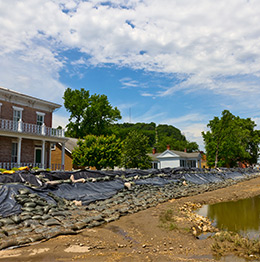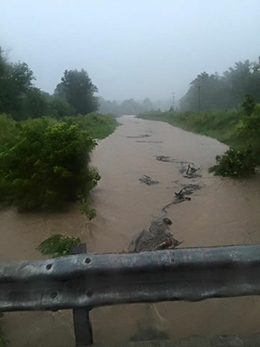Flood Driving Safety
More than half of all flooding deaths are in motor vehicles. Be aware that very small streams, gullies, creeks, culverts, dry streambeds, that appear harmless in dry weather are often the most dangerous areas when flash flooding occurs. Many flash flooding deaths occur when vehicles are swept off low-water crossings that are not meant to be crossed during flooding. Remember – TURN AROUND, DON’T DROWN!
- If you must drive when it’s flooding to get somewhere safe, check MoDOT’s Traveler Info Map for road closures.
- MODOT also has a page specific to the 2019 Flooding in Northwest Missouri where you can quickly see information on Road Closings, Detour Information, and related news.
- Never expect barriers to block off flooded low-water crossings or bridges because floodwaters often rise so quickly authorities cannot close a road in time.
- Never think that because you made it across a flooded low water crossing in the past that you’ll make it the next time.
- Never be tempted to drive into floodwater because it appears shallow. Looks are deceiving and the roadway may not be intact. Floodwater often washes out roads or compromises their structural integrity.
- If you wind up in flood water and your vehicle stalls, leave it immediately and seek higher ground. Rapidly rising water may engulf the vehicle and sweep it away.
Learn more about driving safely during a flood.
Evacuating During a Flood
Be aware of flood hazards no matter where you live, but especially if you live in a low-lying area, near water or downstream from a dam. When a flash flood watch is issued, you’ll need to evacuate on a moment’s notice. Take steps to prepare for a flood before one happens.
- Sign up for severe weather alerts and listen to news reports for the latest information.
- Make a Family Emergency Plan and prepare an emergency kit.
- If you have time, turn off gas, electricity, and water.
- Disconnect all appliances and if possible move any valuable household items to an upper level.
- Check on neighbors, friends and family members who may need assistance with evacuating.
- Construct a sandbag emergency levee.
Flood Water Safety
If there is a chance of flash flooding, move immediately to higher ground. Flash floods are the #1 cause of weather-related deaths in the U.S. Even after initial flooding, rain from other areas in the state can change water levels to rise again.
- Avoid camping or parking along streams, rivers, and creeks during heavy rainfall. These areas can flood quickly and with little warning.
- Just six inches of moving water can knock you down, and 1 foot of water can sweep your vehicle away. Swift currents could potentially suck you into storm drains.
- Don’t let your kids swim or play in the flood water, even if it’s not moving. There could be raw sewage, hazardous waste, or sharp objects below the surface.
- Don’t stand directly on bridges or other structures that are above rising flood water because they could potentially collapse.
Power Outages After a Flood
Floods can cause damage to both above-ground and underground electrical equipment, which can affect service in many areas. Never enter a flooded area where water may be electrically charged from electrical appliances or underground and downed power lines.
- If someone is electrocuted, call 911 and take these steps.
- Before turning the power in your house back on, call your service provider and have an electrician make sure it is safe.
- If a generator is your only current option for power, follow these tips and NEVER run a generator inside a home or garage, or connect it to your home’s electrical system.
- Even with the generator outside, carbon monoxide can still leak into your home through open windows or doors. Know the signs of carbon monoxide poisoning.
Learn more about safety during power outages.
CDC Safety Tips
Flooding comes with many health and safety risks. If you know how to reduce the harm and protect your overall health it can significantly help ease the burden of a major disaster. Personal hygiene and wound care for victims, proper immunizations for cleanup crews, and the risk of mold are all common issues that are explained by the Centers for Disease Control and Prevention.




